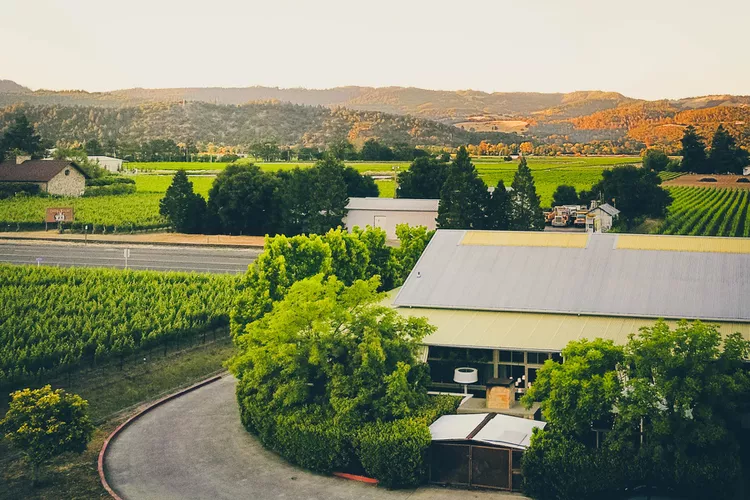Dining at Press
I was dining at Press in the Napa Valley town of St. Helena when my partner’s uncle, Daniel Baron, opened the restaurant’s 245-page wine list and took a trip down memory lane. There was Silver Oak Napa Valley from 1996 (the year he took charge of making that wine), and the same wine from 2017 (the year he retired from Silver Oak); five vintages of Dominus Proprietary Red, pre-1993, when he was the winery’s manager; a reisling “Johannesberg Auslese” made at Chateau Montelena in 1972, when he was a field hand working in the estate’s vineyards.
“I can trace almost my whole career by the bottles in Press’ cellar,” he said. And he isn’t alone. Press holds the world’s largest collection of Napa wines, many displayed in a glassed-in cellar, with labels dating to the 1950s. From its advent as a down-home steakhouse in 2007 to today, with its Michelin star and Wine Spectator Grand Award, this family-owned establishment in a light-filled space on the St. Helena Highway is dedicated to Napa, its history, and the ageability of its wines.
Impressive Wine Selection
“It’s always fun when there’s a guest ordering a bottle, and that vintner happens to be in the restaurant. I can’t tell you how many times I’ve walked up to a table and thanked them for their support because they’ve ordered our wine,” says Scott Gould, vice president of national sales for Opus One; he often entertains clients at Press. “You get to try wines from decades ago that show what Napa is capable of.”
The 1997 White Rock Vineyards Napa Valley Claret that wine director Vincent Morrow uncorked for Dan and I tasted so fresh and nimble that it opened my mind to Napa cab—a wine I’d found too jammy and woody in the past. A 2005 Topaz Special Select Late Harvest sauvignon/semillon blend that Morrow poured with dessert was as good as any French sauternes I’ve had.
The Evolving Menu
Currently at 2,600 selections, Press’ list originated with the late Leslie Rudd, a Kansan food and beverage magnate who became a Napa vintner and restaurateur. “My dad traveled all over,” says Samantha Rudd, his daughter, who now owns the restaurant. “When he was in France, restaurants served French wine. In Spain, it was Spanish wines. In America, they’d sell a chardonnay by saying it’s like a Burgundy. He said, ‘Why aren’t we putting our own wines on a pedestal?’ That’s what drove the wine list.”
Rudd remembers dinners with local luminaries like Robert Mondavi’s widow, Margrit Mondavi, and Warren Winiarski of Stag’s Leap. However, after her father’s prolonged illness, Press declined. Rudd took charge and in 2020, recruited Morrow, a master sommelier with French Laundry pedigree, who reorganized the cellar. He was following the lead of his former French Laundry colleague, Press’ new executive chef/partner Phillip Tessier. Tessier’s menu overhaul rankled the old regulars, “but it was time,” Rudd says. “Napa cab and steaks always go together, but there’s a way to elevate Napa wines with finer food.”
Now on the menu: Tessier’s melty-rich ricotta gnudi wrapped in squash blossoms; his braised abalone lacquered in ponzu sauce; the sliced pig’s ears, spicy-sweet with espelette glaze; and a salad of vibrant greens from a farmer down the road.
Napa Wine Culture
“We change the menu based on what’s growing in Napa,” Tessier says. In early spring, there’ll be a pea custard, “because cover crops, like the peas that have been growing between vines, are coming through,” he says. “Mushrooms are in swing with all the rain, so we’ll put black trumpets on.” Moreover, when mustards will be flowering, he’ll plan a fish dish with a mustard blossom condiment. Unlike at his former gigs, Press is “playful — you can feel relaxed.” Consequently, that’s a reflection of Napa, too, a region Tessier calls “the wild west.”
“You go to one winery here, and there’s a Frenchman who grew up in Bordeaux. You go to another, and it’s a self-made guy from Montana. That’s fascinating,” he says. “At the French Laundry, I never felt a connection to the region. Here, winemakers are sitting at the bar. These are people that most wine drinkers would kill to meet, and they’re regulars.”
Easter eggs like that fill the list: 1969 Chappellet cabernet sauvignon, “one of greatest wines to ever come out of Napa,” according to Morrow; 1973 Stags Leap Vineyard cabernet, the winner of the Judgment of Paris, the fabled 1976 competition between Bordeaux and Napa. However, not every wine is an old cab. “I’m a cheerleader for the history, but I don’t drink Napa cabernet daily,” Morrow says. “That allows me to be more objective about wines we do add to the list,” he adds. That includes innovations by producers who’ve “worked their way up the Napa chain,” he says. For instance, the 2019 Gravels, a rare Rhône blend by Newfound Wines using carignane and grenache grapes. “For every seven new Napa cabernets launched each year, there’s something different and exciting like that. It’s important to support them.”
Because no matter how many venerable and monied wineries Napa has today, the Valley started with individuals like Dan Baron—a hippie kid who landed here in 1970—as well as ambitious, new producers. Those are the ones vinifying their wines in their off-hours and scraping together the money necessary to bottle them. Press reflects that reality as well.
“I always want to maintain the older-vintage backbone, but Vinny pushes me to also look for the new,” Samantha Rudd says. “We have to be on the forefront of the trends in Napa, taking risks. This valley is meant to be a food and wine mecca, and we have to keep pushing what Napa can do. There’s so much cachet here that the restaurant industry rests on its laurels. It was time, at least at Press, to not do that anymore.”





